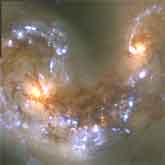The First Starlight
 Imagine being able to see our Universe 14 billion years ago when it was just a baby. If we had a time machine, we could go back and watch how its infant features emerged after the Big Bang. There are many questions about that early time: Which came first, stars or galaxies? Did stars appear one at a time, or in massive flurries of simultaneous creation? Scientists have theories, but how wonderful it would be to actually look back in time and see for certain.
Imagine being able to see our Universe 14 billion years ago when it was just a baby. If we had a time machine, we could go back and watch how its infant features emerged after the Big Bang. There are many questions about that early time: Which came first, stars or galaxies? Did stars appear one at a time, or in massive flurries of simultaneous creation? Scientists have theories, but how wonderful it would be to actually look back in time and see for certain.
Well believe it or not, time machines do exist -- they're called telescopes. Astronomers who peer through them see stars and galaxies not as they are now, but as they appeared when the starlight began its journey. Through telescopes, astronomers can 'travel' billions of years into the past.
Astronomer Richard Ellis of the California Institute of Technology recently used NASA's Hubble Space Telescope to travel backwards nearly to the time of the Big Bang itself. He and his colleagues went in search of newborn stars -- the first ones to appear in our Universe. Ellis explains: 'At some point a billion or so years after the Big Bang, gravitational attraction caused the gas that filled the Universe to collapse and form the first stars. Searching for signs of those stars, which we call First Light, is one of the most interesting challenges in modern astronomy.
About the Author
NASA Marshall Space Flight Center
 The George C. Marshall Space Flight Center, located in Huntsville, Alabama, is the U.S. government's civilian rocketry and spacecraft propulsion research center. As the largest NASA center, MSFC's first mission was developing the Saturn launch vehicles for the Apollo program.
The George C. Marshall Space Flight Center, located in Huntsville, Alabama, is the U.S. government's civilian rocketry and spacecraft propulsion research center. As the largest NASA center, MSFC's first mission was developing the Saturn launch vehicles for the Apollo program.


